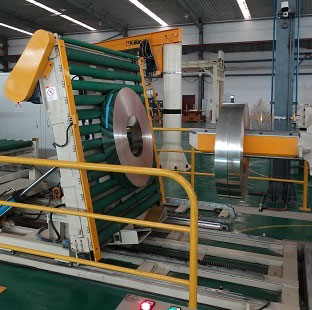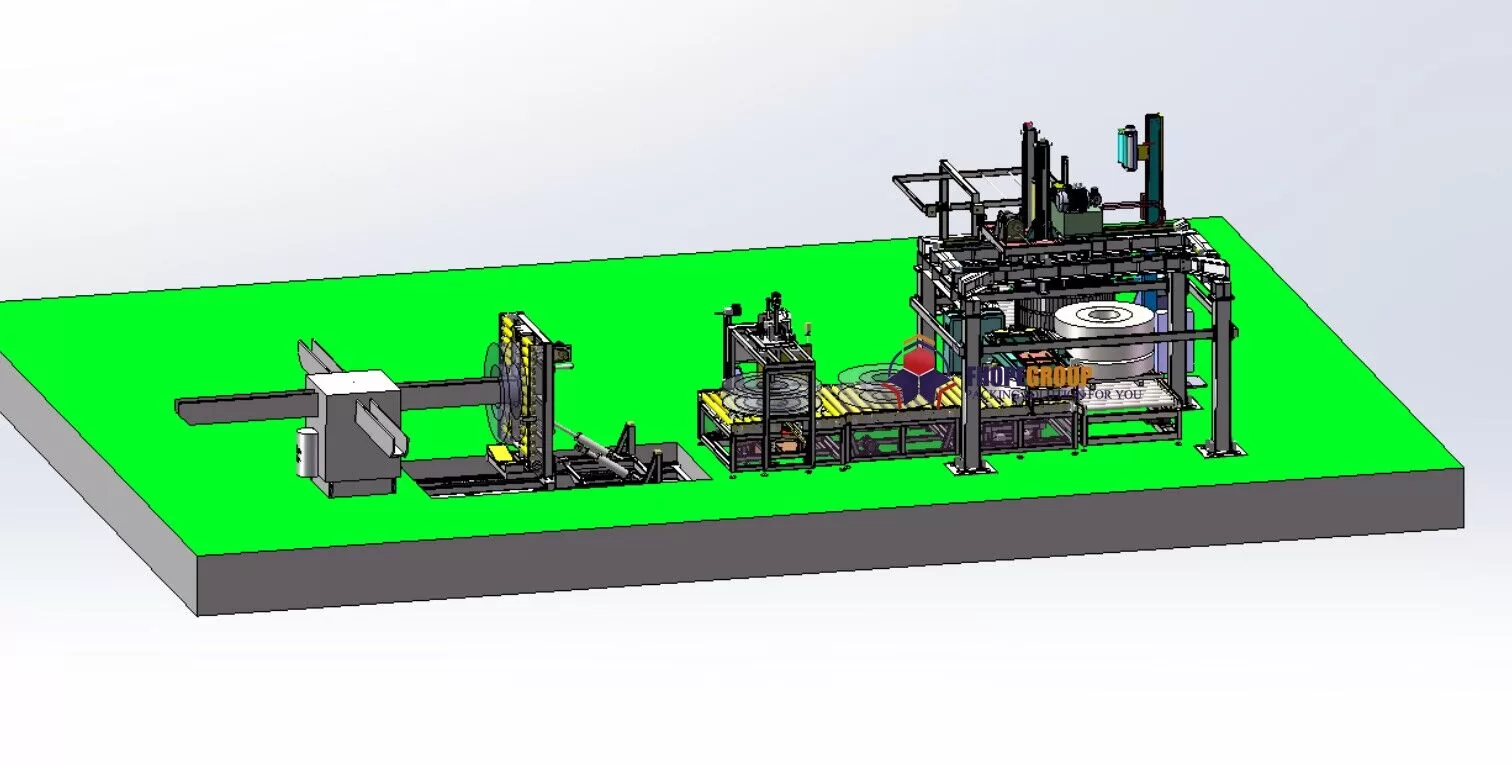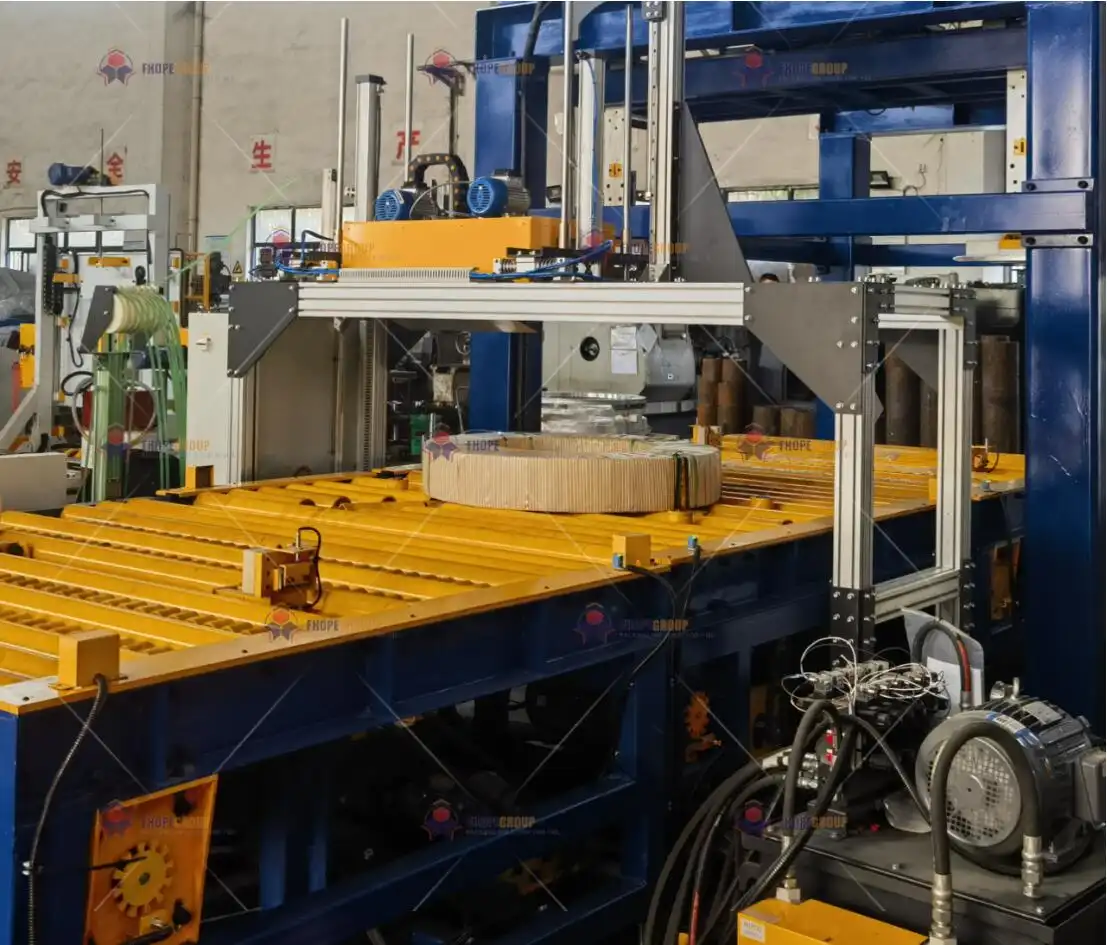Are you running a steel mill and constantly fighting against rising costs? You see your energy bills fluctuate, and your skilled labor costs continue to climb. Your aging equipment is becoming a source of frequent downtime, threatening production schedules and eating into your profit margins. Many mill owners I speak with feel this pressure daily. They know they need to modernize, but the path isn't always clear. They are looking for a solution that doesn't just fix one problem but strengthens their entire operation for the future.
Turkish steel manufacturers are investing in automatic coil packing lines because this technology directly addresses their most significant challenges. It drastically reduces labor costs, improves operational efficiency, ensures consistent package quality for demanding export markets, and enhances worker safety. This strategic upgrade is not just a cost-saving measure; it is a vital step for them to maintain a competitive edge in the global steel industry.

This might seem like a straightforward decision, but the real impact of automation goes much deeper than the numbers on a spreadsheet. I've been in the packing machine industry my entire career, first as an engineer and now as a factory owner. I’ve seen firsthand how a well-designed packing line can transform a business. It's about more than just wrapping coils. It's about creating a smoother, faster, and more reliable end-of-line process that supports your entire production chain. Let's break down the specific reasons why leaders in the Turkish steel industry are making this move and how it could apply to your own operations.
How Can an Automatic Line Directly Tackle Rising Labor and Energy Costs?
Do you find yourself allocating more and more of your budget to your packing department? The cost of skilled labor is always increasing, and finding reliable workers for physically demanding jobs is a constant challenge. Then there are the energy bills, which can spike unpredictably and disrupt your financial planning. You might feel like these costs are out of your control, a constant drain on your profitability. This situation makes it hard to invest in growth and innovation.
An automatic coil packing line directly tackles these costs by fundamentally changing how your packing process works. It reduces the need for manual labor to just one or two supervisors, freeing up your skilled workforce for more valuable tasks. It also optimizes the use of packing materials and operates with high energy efficiency, giving you predictable and lower operational expenses.

Dive Deeper
Let’s get into the specific ways automation generates savings. This isn't just about cutting one or two positions. It's about re-engineering your cost structure for long-term stability. As a business owner myself, I always focus on return on investment, and the ROI here is clear and multifaceted.
Labor Cost Reduction
A manual packing station requires a team of workers. They are responsible for moving coils, applying wrapping materials, and strapping the final product. This work is physically demanding and repetitive, which can lead to high employee turnover and safety risks. An automatic line transforms this. A single operator can oversee the entire process from a control panel. The machine handles the heavy lifting, the precise wrapping, and the secure strapping. This immediately reduces your direct labor costs. But the savings go further. You also reduce costs associated with recruitment, training, and potential injury claims. Your valuable team members can be reassigned to roles that require human problem-solving and expertise, like quality control or machine maintenance.
Material Consumption Control
In manual packing, material usage can be inconsistent. One worker might use more stretch film than another. A misplaced strap can mean wasted material and a poorly secured coil. Automatic systems are programmed for precision. They use sensors to measure the coil's dimensions and apply the exact amount of packing material needed every single time. This consistency eliminates waste. Over a year, saving just 10-15% on wrapping film and strapping across millions of tons of steel adds up to a significant financial saving.
Energy Efficiency
Modern automatic packing lines are designed with energy efficiency in mind. They use high-efficiency motors and smart control systems that power down components when not in use. This contrasts sharply with older, semi-automatic equipment that might run continuously. Furthermore, the speed and reliability of an automatic line mean it can clear your production output quickly. This prevents bottlenecks and allows your primary production lines, like slitters and rolling mills, to run without interruption, maximizing the energy you've already spent in those upstream processes.
| Cost Factor | Manual/Semi-Automatic Packing | Automatic Coil Packing Line |
|---|---|---|
| Labor Requirement | 3-5 workers per shift | 1 supervisor per shift |
| Material Usage | High and inconsistent; prone to waste | Optimized and precise; minimal waste |
| Energy Consumption | Moderate to high; often continuous operation | Low; uses energy-efficient motors and smart controls |
| Operational Speed | Slow; dependent on worker speed | Fast and consistent; 30-60 coils/hour |
| Cost Predictability | Low; subject to wage inflation and material price spikes | High; predictable operational and maintenance costs |
What is the Real ROI on Upgrading from Aging Semi-Automatic Systems?
Your current packing equipment has served you well for over 15 years, but now it's becoming a liability. You experience more frequent breakdowns, which halt your entire production line. Finding spare parts is getting harder and more expensive. You know an upgrade is necessary, but as a business owner, you need to justify every major capital expenditure with a solid return on investment (ROI). The initial cost of a fully automatic line seems high, and you need to be certain the long-term benefits will outweigh it.
The real ROI of upgrading to an automatic line comes from a combination of direct cost savings and crucial intangible benefits. Financially, the reduction in labor, material waste, and downtime often leads to a payback period of just two to three years. Beyond that, the improved product quality, enhanced safety, and increased throughput provide a lasting competitive advantage that strengthens your business for years to come.

Dive Deeper
When I work with clients like you, I encourage them to look beyond the initial price tag. The true cost of a machine is not what you pay for it; it's what it costs you to run it—or not run it—over its entire lifespan. Let's break down the ROI calculation into tangible and intangible factors.
Calculating Tangible ROI
This is the part we can easily quantify on a spreadsheet. The main drivers are:
- Reduced Labor Costs: Calculate the annual salaries, benefits, and overhead for the workers you can reassign from the packing line. This is your most immediate and predictable saving.
- Reduced Material Costs: Analyze your current annual spending on stretch film, VCI paper, and steel or PET strapping. Based on the precision of an automated system, a conservative estimate of 15% savings can be applied.
- Increased Uptime and Throughput: This is a huge factor. Calculate the cost of downtime per hour for your entire production line. If your old packing machine causes even five hours of downtime a month, the losses are massive. An automatic line with 95%+ uptime turns that loss into productive, profitable time. It allows you to process more coils per day, increasing your total sales capacity without changing anything else in your plant.
Factoring in Intangible Benefits
These benefits are harder to assign a specific dollar value to, but they are critically important for long-term success.
- Improved Product Quality: Inconsistent manual wrapping can lead to damaged coils during transit. A single rejected shipment can damage your reputation and lead to costly returns. Automation ensures every coil is perfectly protected, enhancing customer satisfaction and protecting your brand.
- Enhanced Worker Safety: Moving heavy coils and operating strapping tools manually carries inherent risks. An automatic line removes workers from these hazardous tasks, creating a safer work environment. This improves morale and reduces the financial risk of accidents.
- Future-Proofing Your Operation: An investment in automation is an investment in your factory's future. It prepares you for higher production volumes and integrates with modern data systems (MES, IoT), which is essential for a smart factory.
| ROI Component | Semi-Automatic System (Annual Cost/Loss) | Automatic Line (Annual Gain/Saving) | Notes |
|---|---|---|---|
| Labor (4 workers) | -$200,000 | +$150,000 (reassign 3, keep 1) | Based on average loaded labor cost |
| Material Waste | -$50,000 (15% waste) | +$45,000 (waste reduced to <2%) | On $300k annual material spend |
| Downtime Losses | -$120,000 (10 hrs/month @ $1k/hr) | +$108,000 (uptime increases to 98%) | Prevents upstream production halts |
| Total Tangible ROI | -$370,000 | +$303,000 | Payback often within 2-3 years |
How Does Automation Improve Product Quality and Market Competitiveness?
You've built your steel mill's reputation on quality. But your customers, especially in demanding industries like automotive and appliances, have standards that are only getting stricter. A coil that arrives with surface scratches from poor handling or rust from inadequate wrapping can lead to a rejected shipment. In a competitive market, you can't afford these mistakes. You are struggling to ensure that every single coil that leaves your factory is perfectly protected and presented.
Automation provides the consistency and precision needed to guarantee high-quality packaging for every coil. This protects the product during shipping and handling, ensuring it arrives at your customer's facility in perfect condition. This reliability enhances your brand's reputation, allows you to confidently serve high-value export markets, and makes you a more dependable supplier, strengthening your market position.

Dive Deeper
When I started my journey as an engineer, I learned a simple truth: the final package is the last thing you do, but it's the first thing your customer sees. It represents the care and quality of your entire process. For global players like the Turkish steel mills, who export a large portion of their products, perfect packaging isn't a luxury; it's a requirement for market access.
Consistent and Secure Packaging
A human operator, no matter how skilled, will have slight variations in their work throughout a long shift. The tension of the stretch film might vary, or the placement of edge protectors might be slightly off. An automatic coil packing machine eliminates these variables. It applies materials with computer-controlled precision.
- Wrapping: The film is applied with consistent tension and overlap, creating a tight, waterproof, and dustproof barrier. This is crucial for preventing corrosion, especially for coils that will be shipped overseas.
- Strapping: Straps are placed at exact intervals and tensioned perfectly, ensuring the coil remains stable and secure on the pallet. This prevents shifting during transport, which is a major cause of edge damage.
- Labeling: Automated systems can apply labels with barcodes and product information in the same spot every time, simplifying logistics for both you and your customer.
Meeting Export and Industry Standards
Different markets and industries have unique packaging specifications. The automotive industry, for example, has zero tolerance for surface imperfections. An automatic line can be programmed with different "recipes" for different customers. With the press of a button, the operator can switch from a standard domestic pack to a heavy-duty, multi-layer export pack that meets specific international standards. This agility allows you to confidently pursue new, high-margin markets without worrying if your packaging can meet the requirements.
| Packing Parameter | Manual / Semi-Automatic | Fully Automatic Line |
|---|---|---|
| Wrap Tension | Inconsistent, varies by operator and fatigue | Consistent, computer-controlled |
| Package Appearance | Variable, can look unprofessional | Uniform and highly professional |
| Protection Level | Adequate but prone to human error | Superior; engineered for maximum protection |
| Compliance | Operator-dependent | Programmable for specific customer standards |
| Damage/Rejection Rate | 2-3% | <0.5% |
Why Do I Believe a Packing Line is More Than a Machine, But a Strategic Partnership?
You are a practical entrepreneur. You need more than just a piece of equipment. You need a solution that works for your factory, backed by a team you can trust. You have faced suppliers who disappear after the sale is made, leaving you to deal with technical issues on your own. For a critical investment like this, you are looking for a strategic partner who understands your business, supports you through the entire process, and helps you adapt to future challenges.
I believe a packing line is a long-term commitment, and that’s why I founded SHJLPACK on the principle of partnership. From my own experience building a factory, I know that success comes from reliable equipment and reliable people. A true partner doesn't just sell you a machine. We work with you to design the right solution, we ensure it's installed and running perfectly, and we provide ongoing support to help your business grow. This is about building a relationship, not just completing a transaction.

Dive Deeper
When I started as an engineer on the factory floor, I saw the frustration that came from poorly supported equipment. When I built my own factory, I swore I would do things differently. I achieved my own success by building strong relationships with my clients, and now my mission is to share that knowledge and approach. This philosophy, "TOTAL SOLUTION FOR WRAPPING MACHINE," is at the core of everything we do.
Initial Consultation and Custom Design
Every steel mill is different. Your layout, your production flow, and your product mix are unique. A one-size-fits-all machine is not a solution. Our process begins with understanding your specific challenges and goals. We analyze your coil sizes, production speed, and factory layout. I personally get involved in these discussions because my engineering background helps me see the practical challenges. We then design a line that integrates seamlessly into your existing operations. This might mean customizing conveyor heights, choosing the right wrapping materials, or integrating with your MES for data exchange. This is where partnership begins: with a shared understanding of the goal.
Installation, Training, and Commissioning
The best machine in the world is useless if it's not installed and operated correctly. Our commitment extends to being on-site with your team. Our engineers supervise the installation and perform rigorous testing to ensure everything runs as designed. But we don't stop there. We provide comprehensive training for your operators and maintenance staff. We want your team to feel confident and capable of running the line efficiently and handling routine maintenance. We stay until the line is fully commissioned and you are seeing the performance we promised.
Long-Term Support and Modernization
The world changes, and your business needs to adapt. A true partner stands by you for the long run. We provide ongoing technical support and a reliable supply of spare parts to maximize your uptime. More importantly, as technology evolves, we can help you modernize your line. This could involve software updates to improve efficiency, adding new sensors for predictive maintenance, or retrofitting new modules to handle different products. Our goal is to ensure that your investment continues to deliver value for 15, 20 years or more.
| Partnership Stage | A Typical Supplier | SHJLPACK's Approach |
|---|---|---|
| Sales Process | Focuses on machine features and price. | Focuses on understanding your problem and goals. |
| Design | Offers standard models. | Provides a custom-engineered solution for your factory. |
| Installation | Ships the machine with a manual. | On-site engineers supervise and train your team. |
| After-Sales Support | A remote helpdesk or service ticket system. | A dedicated contact and long-term modernization advice. |
| Relationship | Transactional | A long-term partnership for growth. |
Conclusion
Turkish steelmakers invest in automation for survival and growth. This strategic choice delivers lower costs, higher quality, and a competitive edge, ensuring a stronger, more profitable future.





